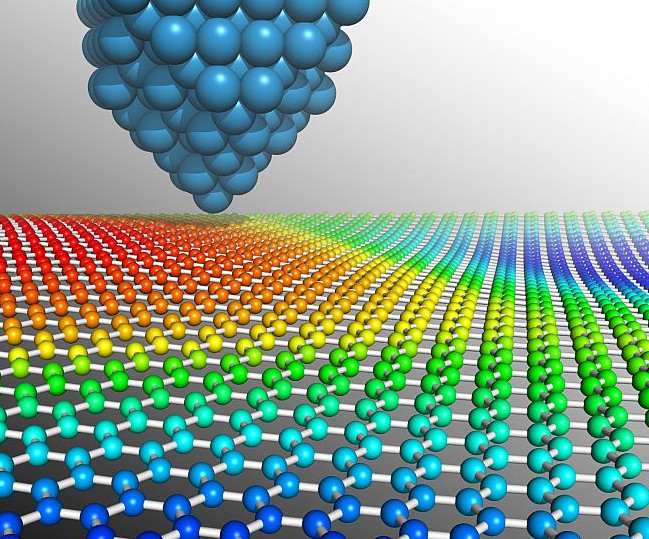Week 8: Nanotech + Art
Nanotech + Art
Nanotechnology studies and manipulates materials in the nanoscale. It was discussed by Richard Feynman in "There's Plenty of Room at the Bottom" in which he highlighted the "enormous potential" for development in the field of nanosciences (Feynman 1). Since then, we have seen this potential be explored in many disciplines including developments in semiconductors, dyes and pigments, and nanomedicine. Many of these advances have depended on novel approaches to design and manipulate nanostructures, making the involvement of art in the field indispensable.
It is hard to believe what you can't see. The nanoscale is impossible to see, but can be imaged using Scanning Tunneling Microscopy (STM) created by Binnig and Rohrer in 1981 (Chen 573). STM uses a sharp probe close to the surface of the specimen being imaged, and uses electron interactions between the tip and the specimen surface to scan it. This produces a grayscale image which is converted to a contour map, allowing the visualization of the material on the nanoscale level. The technology has since been developed to also allow manipulations at this small scale.
 |
| Scanning Tunneling Microscopy: Probe and Surface |
The use of nanotechnology is widespread even if not widely known and dates back to even the 10th century. Stained glass studied from this period was found to contain gold and silver nanoparticles that reflected light resulting in the bright colors displayed. The use of nanoparticles as pigments can serve as alternatives to replace toxic pigments such as those used in make-up products.
 |
| Nanoparticles and Pigments |
Nanomedicine is also a growing field with exceptional advances. It uses nanoparticles and nanostructures to study, diagnose and treat patients such as by improving the bioavailability of drugs so smaller doses have to be administered due to the small size of nanoparticles that allows more efficient delivery to tissues and organs.
 |
| Drug Delivery Using Nanomedicine |
Although technology has allowed the visualization of nanosystems, it remains a field that requires the observer to pay more attention to their senses outside of what they can see, and allow their imagination to guide them. As Gimzewski and Vesna state, studying and interpreting nanoscience requires a "shift in our perception of reality from a purely visual culture to one based on sensing and connectivity" (7). It is this innate need for creative interpretation that makes the artistic and scientific potential of nanotechnology limitless.
Works Cited
Feynman, Richard. “Plenty of Room at the Bottom.” Michigan State University, Dec. 1959, web.pa.msu.edu/people/yang/RFeynman_plentySpace.pdf.
Chen, C. Julian, and Walter F. Smith. “Introduction to Scanning Tunneling Microscopy.” American Journal of Physics, vol. 62, no. 6, 1994, pp. 573–574, https://doi.org/10.1119/1.17525
Gimzewski, Jim, and Victoria Vesna. “The Nanoneme Syndrome: Blurring of Fact and Fiction in the Construction of a New Science.” Technoetic Arts, vol. 1, no. 1, 2003, pp. 7–24, https://doi.org/10.1386/tear.1.1.7/0.
Chan, Chi. “From Nanotech to Nanoscience.” Science History Institute, 3 Sept. 2020, www.sciencehistory.org/distillations/from-nanotech-to-nanoscience.
Ventola, C Lee. “The nanomedicine revolution: part 1: emerging concepts.” P & T : a peer-reviewed journal for formulary management vol. 37,9 (2012): 512-25.
Image/Video Citations
Duke University Department of Physics. “Scanning Tunneling Microscope.” Scanning Tunneling Microscope (STM), webhome.phy.duke.edu/~hsg/264L/images/stm.html. Accessed 25 May 2023.
Bayda, Samer, et al. “The History of Nanoscience and Nanotechnology: From Chemical–Physical Applications to Nanomedicine.” Molecules, vol. 25, no. 1, 2019, p. 112, https://doi.org/10.3390/molecules25010112.
Tan, Weihong, et al. “Nanomedicine.” The Scientist Magazine®, 1 Aug. 2014, www.the-scientist.com/cover-story/nanomedicine-37087.
Hi Anouska, it's so interesting to think that nanotechnology is used in everyday items , even though not everyone necessarily knows the science behind it. I loved knowing that nanoparticles are used in my favorite cosmetic product in the entire world, sunscreen. Even though I personally can't use mineral sunscreen because of the whitecast, I appreciate that there are better options for protecting our skin and the science behind it.
ReplyDelete